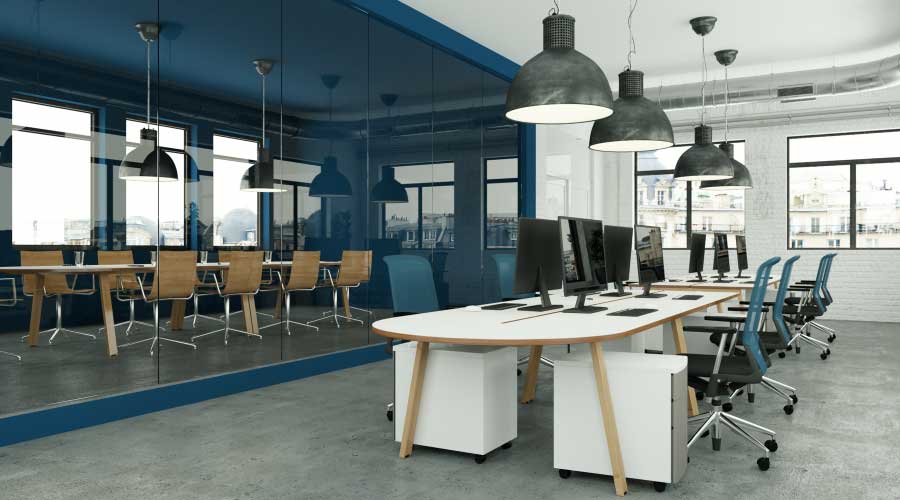4 Lighting Control Options Help FMs Find Best Facility Fit
Occupancy sensing, scheduling with timers, bi-level switching, and daylight harvesting offer energy savings and flexibility for FMs.
1. Occupancy sensing
Occupancy sensing has been in use for decades. Sensors detect activity within an area and automatically turn on the light fixtures. Once activity is no longer detected, the lights are turned off after a predetermined interval.
There are three basic types of occupancy sensors: passive infrared, ultrasonic, and a combination of passive infrared and ultrasonic called dual-technology. Not all are suited for all applications.
Passive infrared sensors detect body heat within a given area. Because they must be able to see the heat source, they work best in smaller, open spaces. Anything that blocks the view of the sensor, such as corners or high furniture, will prevent it from operating properly. In many applications, sensors can be installed as a replacement for standard wall switches.
Ultrasonic sensors emit a high frequency sound wave that is reflected off objects and people in the space. Any movement within the space changes the frequency of the reflected wave, turning the lights on. The sound waves emitted by ultrasonic sensors cover the entire space and are not blocked by furniture or other obstacles. The sensors are very sensitive and can be used in areas with low levels of motion.
Dual-technology occupancy sensors make use of both passive infrared and ultrasonic detection. Lights are turned on only when both sensor types detect occupants. Lights are turned off only when both types of sensors determine that the space is no longer occupied. The combination greatly reduces the number of false activations/deactivations. Dual-technology occupancy sensors are well suited for use in larger spaces.
Occupancy sensors are very effective at reducing lighting energy use, particularly in spaces that have varying use schedules. While the actual energy savings will vary based on use patterns, on average facility managers can expect the use of occupancy sensors to reduce lighting energy consumption by 20 to 25 percent.
2. Scheduling with timers
One of the original methods for controlling building lighting systems, particularly exterior lighting systems, is the use of timers. Timers come in a wide range of mechanical and electronic models. The more sophisticated ones have a battery backup to keep the clock accurate in the event of a power outage. In their simplest operation, users set time when they want the lights to turn on and to turn off. Timers eliminate the accidental operation of lights when they are not needed.
For outdoor use, most timer systems also make use of a photosensor that turns the lights on when needed and off at a preset time. This combination automatically corrects for changing hours of daylight. The biggest drawback of timers is that if the schedule changes, the timer must be manually reset.
Timers are well suited for all types of outdoor lighting. Indoor timers can be used effectively in areas that follow a regular schedule of occupancy. A means must be provided to allow the lights to be turned on if someone must access the area being controlled by a timer.
The energy savings produced by timers depends on the application. On average, you can expect to reduce lighting energy use by ten to 20 percent over manual control.
3. Bi-level switching
Bi-level switching has been widely used in the past as a means of reducing lighting energy use. In its simplest form, two circuits are used to power alternating light fixtures. When the need for lighting is reduced, one circuit can be turned off manually or by a timer. Another type of bi-level switching made use of fluorescent fixtures that used two ballasts. Each ballast was wired to a separate circuit. Turning off one circuit cut the light output of each fixture by 50 percent, but because all fixtures were still producing light, the area was more uniformly lit than when entire fixtures were turned off.
Newer bi-level switching technology makes use of occupancy sensors or photosensors to reduce light output when the space is unoccupied or when lighting is being supplemented by daylight.
Bi-level switching has been used in a wide range of applications from parking garages to stairwells and offices. Bi-level switching maintains sufficient lighting levels when the space is unoccupied yet provides full lighting when people are present. In parking garages, the systems often are set up to switch off perimeter light fixtures when there is sufficient daylight available. Typical savings range from 20 percent to 70 percent for bi-level switching, depending on the application.
4. Daylight harvesting
Daylight harvesting is a technique that makes use of available daylight to reduce the energy use of the lighting system. Early system designs simply switched off lights when they sensed enough daylight was available. However, the abrupt change in lighting levels and the frequent light level changes on days with passing clouds led to complaints and frequent bypassing of the control system.
Today’s systems use dimmable fluorescent or LED light sources that vary their light output in response to available daylight rather than simply switching off. Changes in light output are made gradually, resulting in a more subtle change in lighting levels.
The systems work best in areas with diffuse rather than direct sunlight. The photocells that determine how much daylight is available must be carefully placed so that the levels of light that they are sensing are truly representative of the light levels in the space. Systems can be set up to control light levels in single rooms, multiple rooms with similar daylight levels, or entire zones of buildings. On the average, daylight harvesting control systems produce savings in the range of 25 to 30 percent.
Related Topics:














